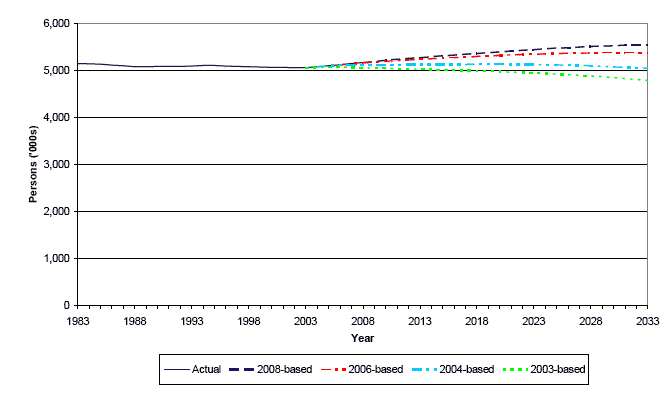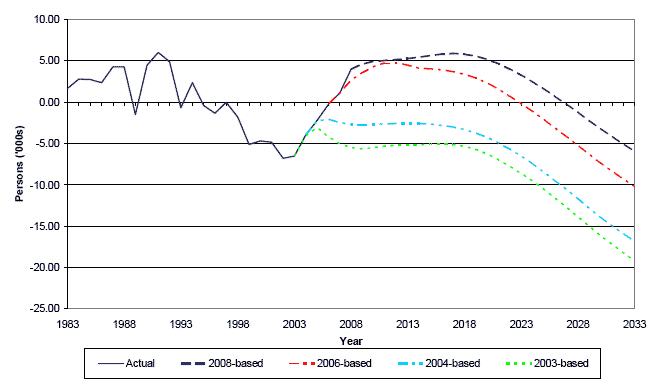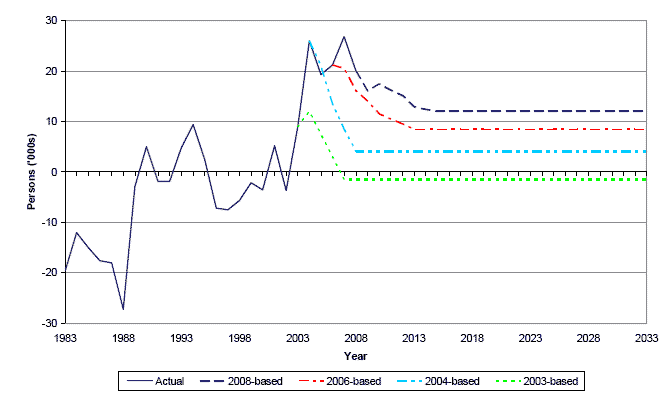
4.1 The last set of projections, published in October 2007, were based on the mid-year population estimates for 2006. The previous projections were based on the mid-2004 population estimates and, prior to this, an interim set of projections, using 2003 as the base year, were produced. The key changes from previously published projections in terms of births, deaths and total population are shown in Table 5a, Table 5b and Table 5c respectively. Section 4.4 looks at the differences in the migration assumptions between the projections. National projections are usually produced every two years – the next set will be 2010-based and is due to be published in October 2011.
4.2 Figure 6 compares the 2008-based projection with previous projections. It shows that the level of the population under the latest projection is higher than for earlier projections and that the population is projected to continue to rise over the next 25 years. Looking further ahead, the population is projected to rise until around 2045 before it begins to decline. However the projections do not show the population falling back to its current level. The 2003-based, 2004-based and 2006-based projections all showed the population decline occurring earlier and showed the population eventually falling below the level in the base year.
Figure 6 Actual and Projected total population compared with previous projections, 1983-2033

4.3 The difference between the projections is due in part to the fact that the population in mid-2008 (on which the projections are based) was around 11,400 higher than the 2006-based projections assumed and in part to the different assumptions about fertility, mortality and migration.
4.4 Figure 7 compares the natural change (the difference between the number of births and deaths) underlying the 2008-based projection with that underlying previous projections. In comparison with the 2006-based projections the number of births is projected to be higher (by an average of around 2,500 per year in the first 25 years of the projection) and the number of deaths very slightly lower (by an average of around 150 per year, again during the first 25 years). As a result there is a higher natural increase between 2009 and 2026 and a reduced natural decrease thereafter. More information on the reasons for the differences is given in Section 3 and in Annex A, Annex B and Annex C.
Figure 7 Actual and Projected Natural Change (Births minus Deaths) compared with previous projections, 1983-2033

4.5 As Figure 8 demonstrates, the long-term migration assumption has been increased from +8,500 in the 2006-based projections to +12,000. This is largely because, since the previous projections were published, migration has continued at a relatively high level (+27,000 in 2006-07 and +20,000 in 2007-08) and, though a reduction is assumed (notably because migration from Eastern Europe is unlikely to continue to be so strongly positive), the previous assumption no longer seems plausible. Migration levels have been so variable in recent years that a trend is hard to identify, and these figures should be treated with caution. Section 7 shows what would happen under various different levels of migration.
Figure 8 Actual and Projected Migration compared with previous projections, 1983-2033

4.6 Table A and Table B below summarise the differences between the 2008-based and the 2006-based projections. The difference in results for the projected age structure of Scotland is small, but the 2008-based projections show a slightly smaller percentage of the population to be of pensionable age and slightly higher percentages to be children or of working age in 2033. As a result the projected number of dependents per 100 of working age is lower in 2033 in the 2008-based projections than in the 2006-based projections.
Table A Projected age structure of Scotland’s population (percentage of total population)
Age Group |
2006-based |
2008-based |
||
|---|---|---|---|---|
2008 |
2033 |
2008 |
2033 |
|
Children |
17.6% |
15.8% |
17.7% |
16.2% |
Working age |
62.6% |
59.4% |
62.6% |
59.7% |
Pension age |
19.8% |
24.8% |
19.7% |
24.1% |
Table B Projected number of dependents per 100 population of working age, Scotland
Age Group |
2006-based |
2008-based |
||
|---|---|---|---|---|
2008 |
2033 |
2008 |
2033 |
|
Children |
28.1 |
26.5 |
28.2 |
27.2 |
Pensioners |
31.5 |
41.7 |
31.4 |
40.4 |
All dependants |
59.6 |
68.2 |
59.6 |
67.6 |